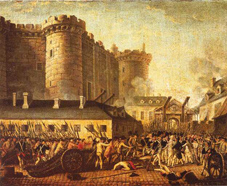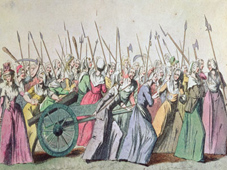 |
Peoples' movements and protests |
 |
|
MobilizationsThe French RevolutionThe republican movementThe Russian revolutionIMF uprisingsBack to Bread seizuresBack to Civil rights movementsBack to Old movementsBack to main page
|
French Revolution
The event that established the concept of ”citizenship” in relation to the state. Until then, one had always been a citizen of a local community. A triangular struggle between a corrupt court, a bourgeoisie that wanted to make the state more effective in taking up the struggle with England, and the ”people”, artisans and peasants, who tried to keep both of these as far away from themselves as possible. The conditions ripened gradually during the 1770s-80s. A speculation economy developed where capital owners tried to cut between producers and consumers instead of invest in production. For example, the price of grain was let loose. Prices tripled or quadrupled, and starvation spread. Desperate non-agriculturalists captured grain transports and bakeries, while the government called the army. Contemporaries talked about "the grain war". In 1789 the government convened a parliament because it needed to replenish the treasury, whereby the bourgeoisie saw a chance to put thumbscrews on the court. But the ”people” were given an early opportunity to assert themselves because, through a series of simultaneous bread uprisings and local revolts against increased prices, it vigorously established a political presence that the bourgeoisie must take into account. In the early stages of the revolution, the representatives of the bourgeoisie tried to build an alliance with some peasants and with the artisans of Paris in order to exert pressure on the court. But the artisans quickly gained an advantage because the plantation slaves in Haiti revolted at the same time, which ruined large parts of the bourgeoisie that had invested in sugar. What gave rhythm to the event was that the high food prices that the bread uprisings were protests against did not fall, because the harvests remained bad. Thus the riots continued and became increasingly threatening. At the same time, the German emperor had sent armies against Paris to quell the revolution. Therefore, the bourgeoisie
became increasingly dependent on keeping up well with artisans and
peasants to get soldiers. In Paris, the artisans was self-controlled,
and the peasants in large parts of the country divided the estates
among themselves. Reading Link
|

